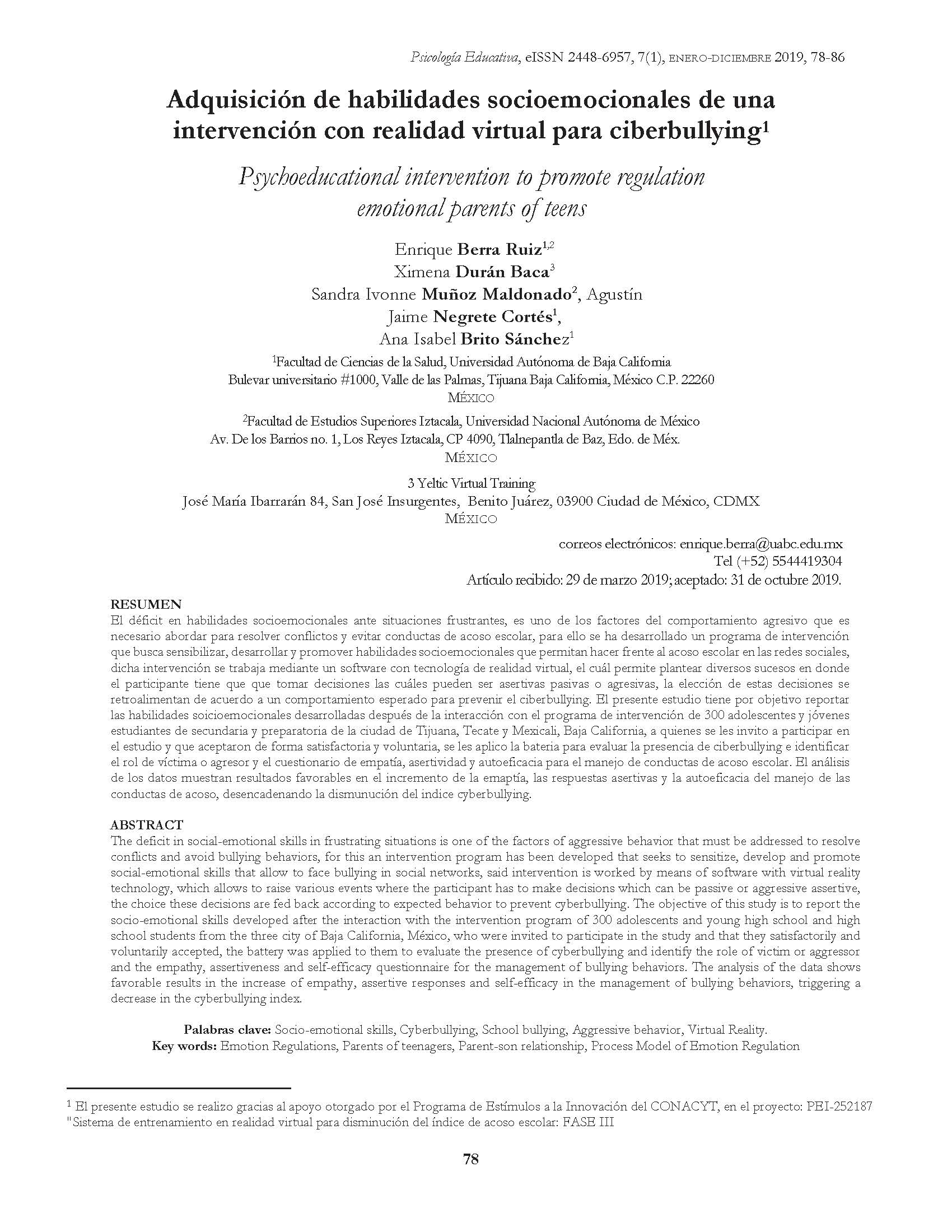Abstract
The deficit in social-emotional skills in frustrating situations is one of the factors of aggressive behavior that must be addressed to resolve conflicts and avoid bullying behaviors, for this an intervention program has been developed that seeks to sensitize, develop and promote social-emotional skills that allow to face bullying in social networks, said intervention is worked by means of software with virtual reality technology, which allows to raise various events where the participant has to make decisions which can be passive or aggressive assertive, the choice these decisions are fed back according to expected behavior to prevent cyberbullying. The objective of this study is to report the socio-emotional skills developed after the interaction with the intervention program of 300 adolescents and young high school and high school students from the three city of Baja California, México, who were invited to participate in the study and that they satisfactorily and voluntarily accepted, the battery was applied to them to evaluate the presence of cyberbullying and identify the role of victim or aggressor and the empathy, assertiveness and self-efficacy questionnaire for the management of bullying behaviors. The analysis of the data shows favorable results in the increase of empathy, assertive responses and self-efficacy in the management of bullying behaviors, triggering a decrease in the cyberbullying index.
References
Bandura, A. (1974). Aprendizaje social y desarrollo de la personalidad. Madrid: Alianza.
Buelga, S., Cava, M. J. y Musitu, G. (2010). Cyberbullying: victimización entre adolescentes a través del teléfono móvil y de Internet. Psicothema, 22(4), 784-789.
Buelga, S., Cava, M. J. y Musitu, G. (2012). Validación de la escala de victimización entre adolescentes a través del teléfono móvil y de internet (CYBVIC). Pan American Journal of Public Health, 32(1)36–42.
Buelga, S., Cava, M.J. y Pons, J. (2009). Cyberbulling: Una nueva forma de maltrato entre los iguales adolescentes. XI Congreso Nacional de Psicología Social. Tarragona: España.
Buelga, S., Iranzo, B., Ortega, J., Torralba, E. y Micó, P. (2013a). Relations between cyberbullying and antisocial behaviours in-and out- of- school context. First International Congress Students´ Engagement in School: International Perspectives of Psychology and Education. Lisbon: Portugal.
Buelga, S., Ortega, J., Iranzo, B. y Torralba, E. (2013). Cyberbullying influence on academic self-esteem and perception of school climate among secondary. First International Congress Students´ Engagement in School: International Perspectives of Psychology and Education. Lisbon: Portugal.
Buelga, S., Ortega, J., Torralba, E., Micó, P. (2013b). Diferencias entre adolescentes agresores y no agresores de cyberbullying en satisfacción con la vida, clima familiar y apoyo social comunitario. III Congreso Internacional de Convivencia Escolar. Almería: España.
Buelga, S., Sánchez, A., Iranzo, B. y Ortega, J. (2013). Ajuste psicológico en adolescentes víctimas de cyberbullying. III Congreso Internacional de Convivencia Escolar. Almería: España.
Burdea, G. (2002). Keynote address: Virtual rehabilitation-benefits and challenges. Paper presented at the 1st International Workshop on Virtual Reality Rehabilitation (Mental Health, Neurological, Physical, Vocational) VRMHR.
Carmona, J., Cangas, A. J., García, G. R., Langer, A. I., & Zárate, R. (2012). Early detection of drug use and bullying in secondary school children by using a three-dimensional simulation program. Cyberpsychology, Behavior, and Social Networking, 15(1), 43-49.
Lucio López, L. A., y González, J. (2012). El teléfono móvil como instrumento de violencia entre estudiantes de bachillerato en México. En Memorias del IV Congreso Internacional Latina de Comunicación Social (pp. 1-10). Tenerife, ES: Universidad de la Laguna. Recuperado de: http://www.revistalatinacs.org/12SLCS/2012_actas/144_ Lucio.pdf
Mc Alister, A. (1998). La violencia juvenil en las Américas: Estudios innovadores de investigación, diagnóstico y prevención. Washington, DC: OPS.
OCDE (2017). Resultados de Programa de Evaluación Internacional de los Alumnos (PISA) 2015 Bienestar de los alumnos. México. Disponible en https://www.oecd.org/pisa/PISA2015-Students-Well-being-Country-note-Mexico.pdf
Olweus, Dan (1998). Conductas de acoso y amenaza entre escolares. Madrid: Ediciones Morata.
Ortega R (1992). Violence in schools: Bully-victims problems in Spain. En Vth European Conference on Developmental Psychology (pp.27). Sevilla: European Society for Developmental Psychology.
Ortega . (1994) Violencia interpersonal en los centros educativos de enseñanza secundaria. Un estudio sobre el maltrato e intimidación entre compañeros. Revista de Educación MEC (304) pp.253-280.
Pérez, V., De la Barra, F., Gubbins, F., Fernández, A. & Rodríguez, J. (2001). Prevención primaria de conductas disruptivas en niños deprimero básico en situación de riesgo psicosocial. Ponencia presentada enXIX Congreso Anual Sociedad de Psiquiatría y Neurología de la Infancia y Adolescencia, Viña del Mar, Chile.
Pérez, V., Fernández, A., De La Barra, F. & Rodríguez, J. (2002). Evolución de conductas agresivas y disruptivas y su comparación en niñoscon y sin intervención preventiva. Ponencia presentada en XV CongresoNacional de Psicología Clínica - VII Congreso Iberoamericano de Psicologíade la Salud, Santiago, Chile.
Pons, J., Buelga, S. y Martínez, B. (2009). Análisis cualitativo de la percepción de victimización en la adolescencia. XI Congreso Nacional de Psicología Social. Tarragona: España.
Zoll, C., Enz, S., Schaub, H., Aylett, R., & Paiva, A. (2006). Fighting bullying with the help of autonomous agents in a virtual school environment. Paper presented at the 7th International Conference on Cognitive Modelling.

This work is licensed under a Creative Commons Attribution-NonCommercial-NoDerivatives 4.0 International License.
Copyright (c) 2024 Universidad Nacional Autónoma de México


